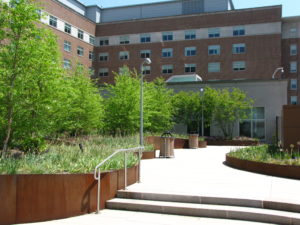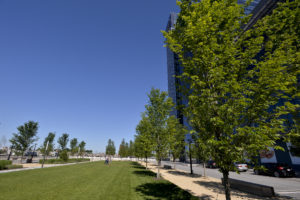Trees on Green Roofs: Drainage and Stabilization
Posted in Blog, green roof, Jobsite Photos, Recommendations on June 29, 2017
When you include trees on a green roof as an integral part of a high-tech building structure, you need to consider many details and have a good strategy to ensure your trees thrive over the long term. Two of the most important areas to have a plan for are drainage and tree stabilization. Each of these will have a direct effect on the health and longevity of your trees.

Drainage on a roof is unique. Unlike planting trees in natural soil, excess water must find its way to roof drains reliably and consistently over the life of the green roof. It’s important to keep in mind that tree roots can develop destructive force over time and can potentially clog roof drains and drain pipes.
Because of this, roof drains must always be accessible for inspection and maintenance. Ideally, you’ll use inspection boxes with a lid at the top and functional connections to the soil drainage layer. This setup allows for regular checks at this critical point, which is crucial for the long-term performance of the drainage system. To ensure inspection and maintenance, trees should never be placed directly above a roof drain.
Tree stabilization is another area that needs careful consideration. Stabilization is critical because wind loads can be much higher on an exposed roof compared to at-grade locations. While there are common stabilization systems available, you must evaluate them carefully because they may not work with limited soil depth or lightweight growth media. In addition, some of these systems require a stake to be driven into the soil, which can easily damage the waterproofing membrane on a roof, and shouldn’t be used on green roofs.

On green roofs, you can consider other options for stabilizing trees, which aren’t common in traditional landscaping. In some situations, you may be able to connect tie downs to surrounding planter side walls or container edges, but the best method is to stabilize trees with anchors at the bottom of the soil system.
Because green roof soil systems, like rooflite’s rooftop trees soil system, are built up from the bottom, it’s easy to bury steel mesh, concrete blocks, lawn grid pavers, or ballast stones to use as anchors for trunk tie downs or root ball strapping. You should place the anchor elements directly above the drainage layer and filter fabric. The other soil layers go on top of the anchor element and keep it in place securely without any need to penetrate the waterproofing membrane.
These recommendations are based on our knowledge of planting trees on many green roof projects throughout the country, but you should always check with your project experts on the best way to design your specific project.
